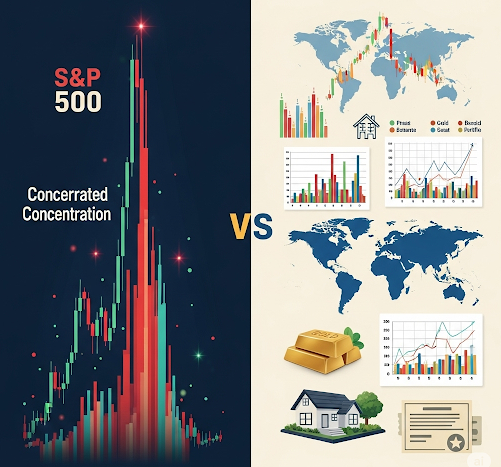A highly rated comment on Reddit’s r/investing neatly summarizes the modern investor’s dilemma: “The S&P 500 feels perfect, but you’re betting on one country and a few companies.” This observation cuts to the core of the investment environment we are in now: the S&P 500’s great performance has made many ask the question: why bother with diversification?
The numbers are clear about the S&P 500 and its domination. The index has returned around 13% a year over the last ten years, making it the kingpin of hundreds of portfolios across the world. After all, the S&P 500, as we mentioned above, has issued gains of more than 20% in back-to-back years, and it’s natural to wonder: why mess around with diversification if the index is treating us so nicely?

But beneath this apparent rosy picture lurks a rather more complicated one. Heading into early 2025, the top 10 companies in the S.&P. 500 were accounting for nearly 40 percent of the index — a concentration that was even higher than at the peak of the dot-com bubble. This concentration, while producing impressive returns can also present risks that a lot of investors may not fully grasp.
Why They Love the S&P
The S.&P. 500 is popular for good reason — it consists of the 500 biggest publicly traded companies in the United States, weighted for market size. With this straightforward format, it has become the world’s most followed stock market index and the bedrock of passive investing.
Consistent Long-Term Returns: The proof of the S&P 500’s run is in the numbers. Through the last 100 years, the index has seen an average annual return of about 10%, making it a good candidate for long-term wealth creation. This is why it has been the standard advice for retirement accounts, college savings and other long-term investment goals.
Simplicity and cheap access: Index funds and ETFs such as SPY, VOO and IVV have made S&P 500 investing available to the masses. Expenses are as low as 0.03% and you get exposure to 500 companies with one purchase. It also strips away the requirement to choose stocks or time the market or to pay steep fees to active fund managers.
Tech Giant Dominance is Driving: The Performance Since the index is market-cap weighted, therefore, companies such as Apple, Microsoft, NVIDIA, and Amazon all hold sway over performance. Shares of tech giants Nvidia and Apple surged by 171% and 33% in 2024, respectively, helping lift the information technology sector. This tilt toward high-growth tech firms has been instrumental in spurring the index’s outperformance.
Why Diversify Your Portfolio?
Diversifying assets is widely considered one of the few “free lunches” in investing that allows the reduction of a portfolio’s risk without explicit trade-offs in returns. At a fundamental level, diversification refers to the practice of spreading investments among various asset classes, geographical regions, and business sectors, all with the aim of insulating oneself from the poor performance of any one investment.
The Modern Portfolio Theory
Modern Portfolio Theory, pioneered by Nobel laureate Harry Markowitz, illustrates that by blending assets that possess noncorrelated risk/return profiles, you may develop portfolios that are more efficient than individual assets on their own. The big idea: Investors can earn a better risk-adjusted return by owning uncorrelated assets than by investing in one asset, no matter how appealing it might seem.
Understanding Risk-Adjusted Returns
The central benefit of diversification isn’t that it necessarily delivers higher returns — it’s better returns relative to the risk you take, as measured by the Sharpe ratio (returns per unit of risk). A diversified portfolio won’t fare as well as the S&P 500 in good times, but it also offers vital protection in the down times.
Diversification won’t make you rich and it won’t prevent you from going broke, but it can make the experience of investing much more palatable by lessening the psychological toll of watching a concentrated portfolio get ravaged during market downturns. Or, as a wisecracks one on Reddit put it: “Diversification is insurance, not a performance enhancing drug.
Final Reflection
As an incredible wealth-creation machine, the S&P 500 manufacturing will likely stay an amazing long-term investment. But history tells us that no one country, sector or asset class reigns supreme indefinitely. By mixing S&P 500 exposure with authentically diversified international stocks, bonds, and other alternatives, investors can create risk-managed portfolios better designed to capture compelling returns in varied economic environments.
The aim is not to ditch what works but to improve what works with additional sources of return and risk mitigation. Over time, the tortoise of diversified, balanced investing often beats the share of concentrated, high-flying portfolios.
For more info:-
online trading platform
forex trading demo account